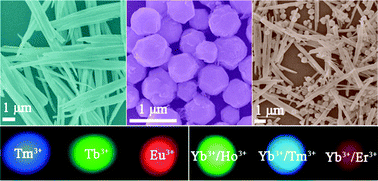Nanometer- or micrometer-sized particles, doped with a small quantity of rare-earth cations, exhibit two types of luminescence. Where the light absorbed is of higher energy than the light emitted (known as down-conversion or DC) the materials can be used in lighting and displays. If the light absorbed is of lower energy than the light emitted (up-conversion or UC), the materials can be used in photonics and biological imaging. The luminescence behaviour depends on the composition, size and shape of the particles and the rare-earth ion (or ions) used for doping.
Lanthanide oxyfluorides, such as YOF, are attractive candidates for the host particles, due to their high stability and good transparency. These materials have been prepared with various particle sizes but using harsh conditions and complicated processes which can, crucially, leave behind traces of the organic molecules used to control morphology. These can be detrimental to the physical and chemical properties of the final product.
A new paper shows how a simple hydrothermal method can be used to prepare YOF particles with controllable size and shape, determined by altering the pH of the reaction mixture and without the need for organic shape-directing reagents. At pH 9 microrods form, while at pH 11 the particles form as nanospheres and at pH 14 there is a mixture of the two morphologies. The UV luminescence properties of samples doped with the rare-earth cations Tm3+, Tb3+ or Eu3+show characteristic blue, green or red DC emissions. Samples doped with two different rare earth cations, under lower energy excitation, show red, blue and green UC emissions for Yb3+/Er3+, Yb3+/Tm3+ and Yb3+/Ho3+ doped particles, respectively (see diagram below).
The emission intensities are related to the particle size and the number of surface defects (which lead to quenching of the luminescence). Intensities are therefore highest for the microrods which are largest and have fewest defects. Authors conclude that the YOF particles prepared are excellent host lattices for efficient luminescence which could find application in colour displays and anti-counterfeit labels.
For more details see the paper at:
YOF nano/micro-crystals: morphology controlled hydrothermal synthesis and luminescence properties
Yang Zhang, Xuejiao Li, Dongling Geng, Mengmeng Shang, Hongzhou Lian, Ziyong Cheng and Jun Lin
CrystEngComm, 2014, Advance Article
DOI: 10.1039/C3CE42323A, Paper
__________________________________________________________________________________________________
 Gwenda Kyd has a PhD in metallocarborane chemistry from the University of Edinburgh. Other research work includes the spectroscopic study of the structure of glasses and organometallic electron-transfer reactions and the preparation of new inorganic phosphors. Currently, she is writing a book on chemicals from plants
Gwenda Kyd has a PhD in metallocarborane chemistry from the University of Edinburgh. Other research work includes the spectroscopic study of the structure of glasses and organometallic electron-transfer reactions and the preparation of new inorganic phosphors. Currently, she is writing a book on chemicals from plants











